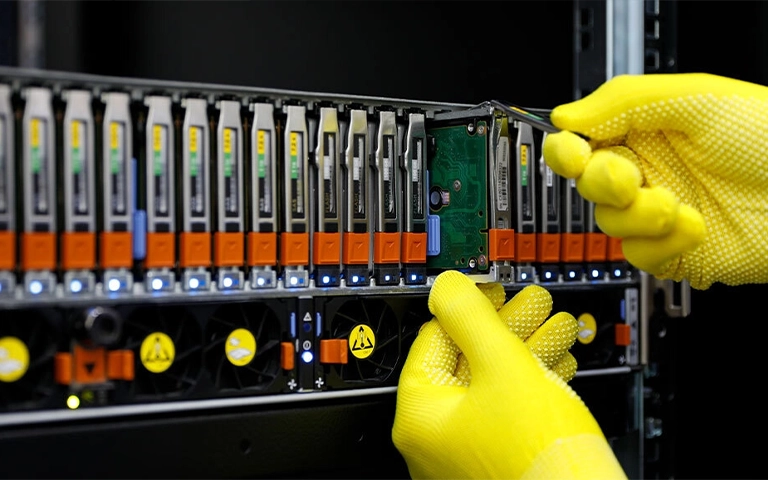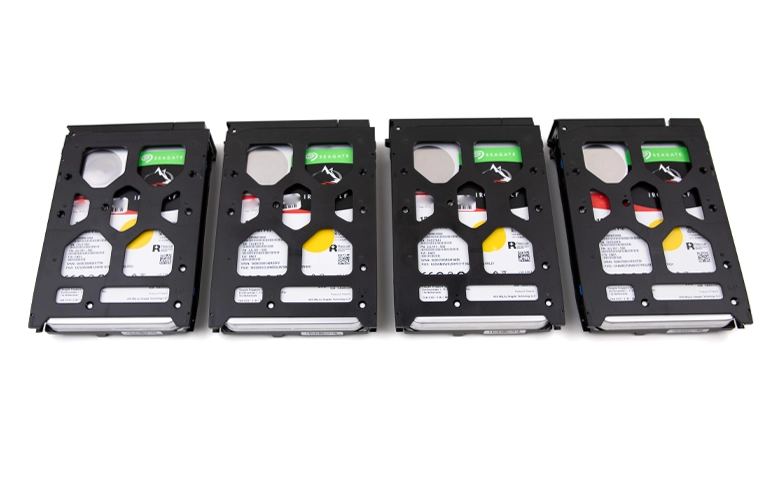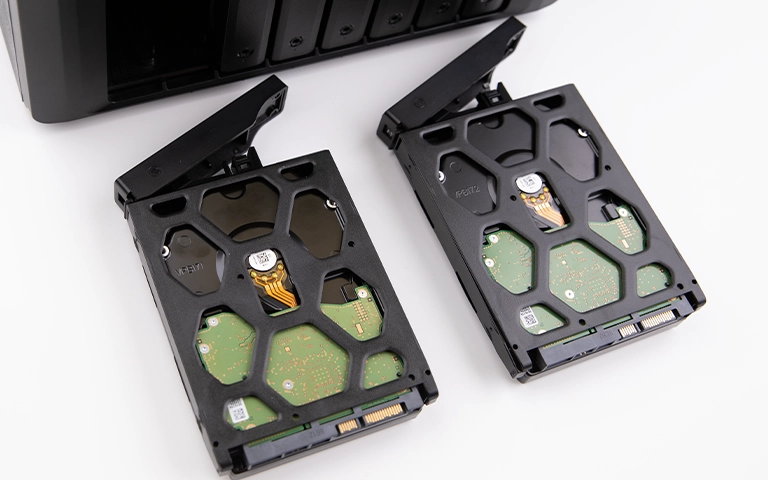RAID 50 is a hybrid configuration that blends the features of RAID 5 and RAID 0. It combines the speed and performance of striping with the redundancy of distributed parity, offering both capacity and data protection. This makes RAID 50 ideal for users who manage large volumes of data and need balanced reliability.
In a RAID 50 array, multiple RAID 5 groups are created first. These groups are then striped together in a RAID 0 configuration.
As a result, you get faster read and write speeds while still maintaining fault tolerance. If a single drive fails within one of the RAID 5 groups, your data remains safe.
This setup is often used in business environments where performance and data security must coexist, such as database servers, virtualization, or multimedia storage systems.
It provides a good compromise between cost, protection, and speed, which explains why RAID 50 remains a popular choice among professionals.

How RAID 50 Works
RAID 50 operates by combining several RAID 5 arrays into one striped RAID 0 set. Each RAID 5 group contains data blocks and parity blocks that allow recovery if one drive fails within that group. The RAID 0 layer then stripes data across these RAID 5 groups, improving read and write performance.
To build a RAID 50, you need at least six drives. For example, if you create two RAID 5 sets with three drives each and stripe them together, you get a RAID 50 configuration. The total capacity equals the sum of all drives minus one drive per RAID 5 group used for parity.
This combination delivers both speed and fault tolerance. The striping (RAID 0) boosts performance by spreading data across multiple drives, while the parity in RAID 5 ensures redundancy within each group. However, if more than one drive fails in the same RAID 5 group, data loss can still occur.
RAID 50 systems are often managed using a dedicated RAID controller, which handles parity calculations and stripe management. Without the proper controller setup, the array can become unstable or even unreadable.
Key Features and Benefits of RAID 50
RAID 50 offers a combination of high performance and reliable data protection, making it suitable for demanding environments. Below are its main advantages:
Enhanced Performance: By striping data across multiple RAID 5 arrays, RAID 50 offers faster read and write speeds than a single RAID 5 setup. It efficiently handles large data transfers for databases and virtual machines.
Improved Fault Tolerance: Each RAID 5 group can tolerate one drive failure without losing data, maintaining availability even under stress.
Scalable and Reliable: RAID 50 allows easy capacity expansion while balancing performance and protection. It’s suitable for businesses expecting data growth or heavy workloads.
Optimized for Multi-User Systems: With high throughput and stability, RAID 50 performs well in shared environments like enterprise servers and file storage systems.

Disadvantages and Limitations of RAID 50
While RAID 50 provides strong performance and fault tolerance, it is not without drawbacks. Understanding these limitations will help you decide if this configuration fits your storage needs.
Requires More Drives: RAID 50 needs at least six drives to function properly. This increases the initial hardware cost, making it less practical for small-scale setups or home users.
Complex Setup and Management: Configuring RAID 50 requires an advanced RAID controller capable of handling multiple RAID levels. Managing such arrays can be challenging, especially when expanding capacity or replacing failed drives.
Risk During Multiple Drive Failures: Although RAID 50 can tolerate one drive failure per RAID 5 group, multiple failures within the same group can result in data loss. This risk makes regular monitoring and maintenance essential.
Longer Rebuild Time: When a failed drive is replaced, the rebuild process can take a long time, especially in large-capacity arrays. During rebuilds, performance may decrease, and the array remains vulnerable until completion.
Higher Cost per Gigabyte: Since one drive in each RAID 5 group is reserved for parity, usable capacity is reduced. The balance between protection and cost should be considered before choosing this setup.
RAID 50 vs Other RAID Levels
RAID 50 combines elements of RAID 5 and RAID 0, offering a balance of performance and protection. To understand where it stands, let’s compare it with other common RAID levels:
From the table, RAID 50 clearly fits in the middle ground, faster than RAID 5 and 6 but with better redundancy than RAID 0. It’s especially effective for environments that handle large I/O workloads, like data centers or virtualization servers.
You can also explore more about RAID 5 vs RAID 6 and RAID 50 vs RAID 60 for deeper comparisons between related configurations.

When to Use RAID 50
RAID 50 is ideal for systems that need both speed and data protection. It fits well in environments where downtime is costly and performance is critical.
Common use cases include:
Virtualized servers: Handles multiple workloads efficiently with high read and write speeds.
Database hosting: Improves query response while maintaining redundancy.
Media and video editing: Supports large file transfers and fast rendering.
Enterprise storage: Offers scalable capacity with reliable fault tolerance.
Research environments: Ensures smooth processing of large datasets.
RAID 50 is best suited for professional setups with a capable RAID controller and proper monitoring. It balances speed, safety, and capacity for data-driven operations.
Fast turnaround times for business-critical data
Dealing with RAID 50 Failures
RAID 50 offers strong redundancy, but it can still fail due to drive crashes, controller issues, or configuration errors. Because it combines multiple RAID 5 groups, recovery is more complex than with standard arrays.
If two drives fail within the same group, the array becomes unreadable. Avoid rebuilding or reconnecting drives without expertise, as this can damage the data structure.
When failure occurs, power down the system and contact professionals. At RAID Recovery Services, we specialize in handling multi-level RAID arrays. Our engineers clone each drive, rebuild the array virtually, and recover data safely.
For detailed information, you can also review our guide on Troubleshooting RAID Failure and RAID Controller Failure Recovery.

Conclusion
RAID 50 combines the speed of striping with the protection of parity, creating a storage system that performs well under heavy workloads while keeping data safe from single-drive failures. Its balance of performance, reliability, and capacity makes it a preferred choice for businesses managing critical applications and large datasets.
However, the same complexity that gives RAID 50 its strength also makes it challenging to recover after a failure. Attempting manual rebuilds can easily result in data overwriting or parity corruption.
If your RAID 50 array becomes inaccessible or shows drive errors, RAID Recovery Services can help. Our specialists handle every stage of the recovery process with precision, ensuring maximum data restoration in a secure environment.
Need professional help? Contact RAID Recovery Services today for expert evaluation and recovery support.
Trust the experts with proven results
Frequently Asked Questions
What is the main advantage of a RAID 50 array?
RAID 50 combines the redundancy of RAID 5 with the speed of RAID 0. It provides faster read and write operations while maintaining protection against single-drive failures within each RAID 5 group.
How many drives are required to build a RAID 50?
You need at least six drives to create a RAID 50 configuration. Each RAID 5 group must contain at least three drives, and multiple groups are striped together for performance.
What happens if two drives fail in the same RAID 5 group?
If two drives fail within the same RAID 5 set, the RAID 50 array becomes unreadable, leading to potential data loss. In this case, professional recovery services are needed to reconstruct the array.
Is RAID 50 suitable for home use?
RAID 50 is typically designed for enterprise systems, servers, and high-performance workstations. It’s not recommended for home users due to its cost, drive requirements, and complex setup.
Can data be recovered from a failed RAID 50 array?
Yes, in most cases data can be recovered. However, it requires advanced expertise to handle the multiple RAID layers. At RAID Recovery Services, engineers use specialized tools to rebuild and extract data safely from failed RAID 50 systems.